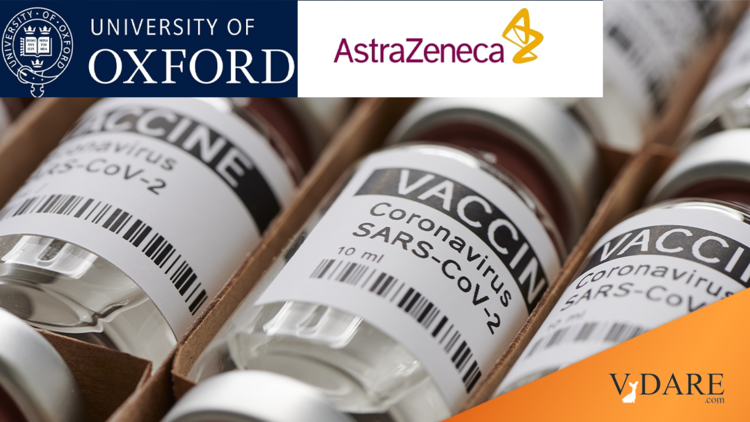
Oxford-AstraZeneca Vaccine Less Effective Than the Two MRNA Vaccines
By Steve Sailer
11/23/2020
From AstraZeneca’s press release:
This announcement contains inside information
Not anymore.
23 November 2020 07:00 GMT
Two different dosing regimens demonstrated efficacy with one showing a better profile
No hospitalisations or severe cases of COVID-19 in participants treated with AZD1222
Positive high-level results from an interim analysis of clinical trials of AZD1222 in the UK and Brazil showed the vaccine was highly effective in preventing COVID-19, the primary endpoint, and no hospitalisations or severe cases of the disease were reported in participants receiving the vaccine. There were a total of 131 COVID-19 cases in the interim analysis.
131 is a pretty sizable number of cases, but one reason they got that high is because it’s less effective in the treatment arm than the Pfizer-BioNTech and Moderna vaccines.
One dosing regimen (n=2,741) showed vaccine efficacy of 90% when AZD1222 was given as a half dose, followed by a full dose at least one month apart, and another dosing regimen (n=8,895) showed 62% efficacy when given as two full doses at least one month apart.
Is there a good reason to think the 1.5 dose regimen is more effective than the 2.0 dose regimen? Or is it just the smaller sample size?
The combined analysis from both dosing regimens (n=11,636) resulted in an average efficacy of 70%. All results were statistically significant (p<=0.0001).
Three weeks ago this would have been exciting, upbeat news. But the Messenger RNA vaccines came out in the 94-95% efficacy range. On the other hand, they are trickier to keep cold enough, so this one might have some use in regions without good electricity.
The vaccine can be stored, transported and handled at normal refrigerated conditions (2-8 degrees Celsius/ 36-46 degrees Fahrenheit) for at least six months and administered within existing healthcare settings.
